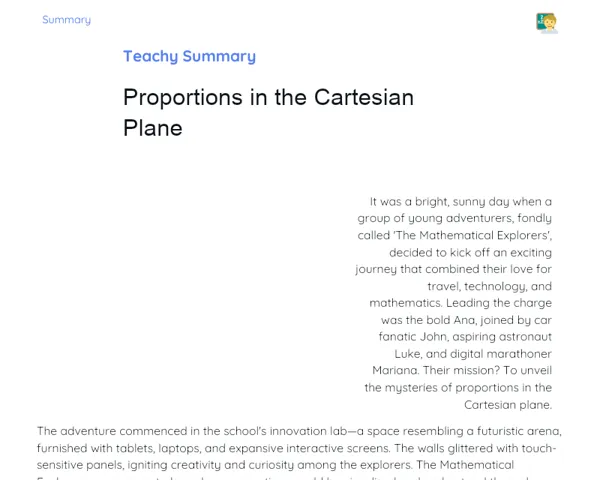Socioemotional Summary Conclusion
Goals
1. Grasp the concept of periodicity in trigonometric functions, focusing specifically on the sine function.
2. Identify and calculate the period of trigonometric functions from their graphs or mathematical forms.
Contextualization
📈 Imagine if you could accurately predict when the tides rise and fall, or when a tune reaches its high notes and low beats. This is what trigonometric functions enable us to do! They serve as guides that illustrate patterns and cycles, from ocean waves to the rhythm of our heartbeats. Let’s embark on this journey together to uncover how intriguing and essential mathematics can be in comprehending our surroundings! 🌍✨
Exercising Your Knowledge
Definition of Trigonometric Function
A trigonometric function links the angle of a right triangle to the ratios of its sides. These functions are crucial for representing periodic phenomena seen in nature and technology, like sound waves, daily rhythms, and movement patterns.
-
Basic Functions: The primary trigonometric functions are sine, cosine, and tangent.
-
Relation to Triangles: They emerge from the connection between the sides of a right triangle and its angles.
-
Practical Applications: These functions represent phenomena such as sound waves, light, and tidal movements, becoming vital in the realms of science and engineering.
Sine Function
The sine function, denoted as sin(x), computes the ratio of the opposite side to the angle and the hypotenuse of a right triangle. Its graph is a sine wave that fluctuates between -1 and 1, showcasing a repetitive pattern that captures the essence of periodicity.
-
Mathematical Definition: Notated as sin(x), it plays a key role in trigonometric calculations.
-
Sine Graph: Displays a wave-like shape that cycles every 2π units.
-
Oscillation: The graph oscillates between -1 and 1, clearly demonstrating cycles of repetition.
Periodicity
Periodicity refers to the tendency of trigonometric functions to repeat at consistent intervals. For the sine function, for example, the standard period is 2π. Grasping this concept is essential for predicting and analyzing recurring patterns in nature and technology.
-
Concept of Period: The period denotes the interval after which the function repeats its values.
-
Period of the Sine Function: For sin(x), the standard period is 2π.
-
Calculation of the Period: For modified functions such as y = sin(bx), the formula period = 2π / |b| is applicable.
Key Terms
-
Trigonometric Function: The relationship between angles and sides of right triangles.
-
Sine Function: Describes the relation between the opposite side and the hypotenuse.
-
Periodicity: The characteristic of functions to repeat at regular intervals.
-
Period: The interval after which the trigonometric function repeats its values.
For Reflection
-
How can you leverage the idea of periodicity to spot patterns in your everyday experiences?
-
Can you think of instances when you needed to exercise self-awareness and self-regulation to tackle challenges in your studies?
-
In what ways can a firm understanding of trigonometric functions empower you to make more deliberate and responsible choices in your daily life?
Important Conclusions
-
Trigonometric functions, particularly the sine function, are essential for modeling recurring phenomena found in nature and technology.
-
The idea of periodicity enables us to foresee and analyze repetitive patterns, with the period of the sine function being 2π.
-
A solid understanding and ability to calculate the period of trigonometric functions are fundamental across various branches of science and engineering.
Impacts on Society
Grasping the nuances of trigonometric functions and their periodic nature significantly influences our daily lives. For instance, sound waves and light, pivotal for communication and illumination, can be described by these functions, leading to advancements in technologies like mobile phones and LED lighting. Furthermore, trigonometry is critical in civil engineering, aiding in the design of bridges and buildings to ensure safety and efficiency.
On an emotional plane, identifying patterns and cycles in different facets of life can improve self-awareness and emotional regulation. For example, understanding that our emotions follow certain cycles can better equip us to navigate our highs and lows, promoting a healthier emotional state. The knowledge behind these mathematical cycles can be a powerful ally for personal and academic growth.
Dealing with Emotions
To manage your emotions while engaging with trigonometry and its real-world applications, try this exercise using the RULER method. Spend a few moments reflecting on an emotion you encountered while studying this topic. Acknowledge that emotion (for instance, frustration or happiness). Next, delve into understanding the root of that emotion by considering what instigated it. Correctly identify the emotion with appropriate terminology. Share this emotion, whether in writing or through discussion with a friend or peer. Lastly, contemplate strategies to effectively regulate that emotion in the future, perhaps through drafting a study plan or exploring additional resources to clarify your queries.
Study Tips
-
Utilize graphs and visual aids to comprehend the periodicity of trigonometric functions. Drawing or using software can enhance your learning experience.
-
Make it a habit to regularly revisit the core principles of trigonometry to fortify your foundation. Collaborate with peers in study groups, discussing and solving problems together.
-
Relate trigonometry to your everyday experiences, such as the music you enjoy or the patterns you observe in nature, to enrich your learning and make it more relevant.



